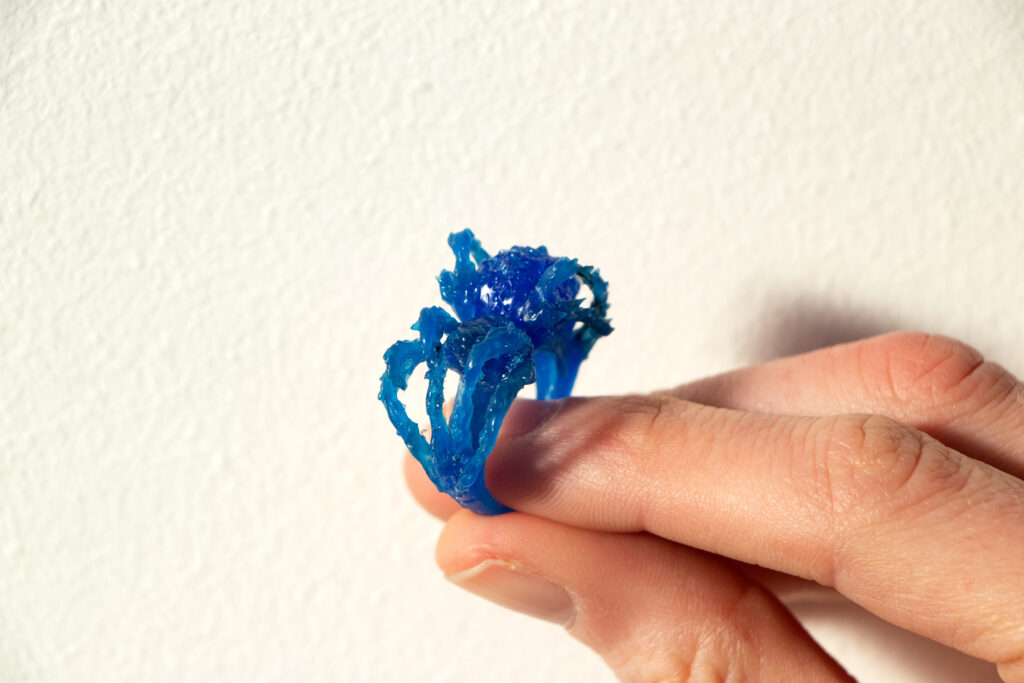Wax carving, a time-honoured practice in jewellery craftsmanship dating back 6,000 years, involves shaping a block of jeweller’s wax through sawing and filing, akin to a sculptor carving stone. Once the wax creation is complete, it is sent to a caster for the lost wax casting process, where it’s enveloped in a hard plaster known as investment, or a special type of sand, and the wax is melted away. This then leaves behind a negative imprint of the piece which is filled with the chosen metal, creating a metal duplicate of the original wax carving. This versatile method allows for the production of multiple replicas of the same piece as a mould can be made and reused.
We joined British Academy of Jewellery (BAJ) Tutor and wax carving specialist Vicky Tawamana in the workshop to learn more about this unique skill and uncover why it’s such a valuable technique to learn. As she carefully crafts a Lion piece she originally drew 20 years ago, Vicky detailed the difference between each wax and the perks of wax carving. “The four main types of wax are distinguished by their unique ‘pliability’. From the exceptionally soft and forgiving pink wax, akin to dentist’s wax and ideal for rectifying errors or mending broken wax, to the progressively firmer green, blue, and purple variants, the range offers a spectrum of melt points.”
Vicky also emphasised the cost-effectiveness of wax carving, explaining that the process requires minimal tools and equipment, and the essentials can be purchased for cheap online. She also highlighted the portability of the method, saying “you can work on it pretty much anywhere, you’ll often find me carving a piece on the couch.” She further underscored the flexibility of the technique since it allows for freehand designs, and noted the added benefit of sustainability – it’s possible to collect and reuse wax shavings during the carving process.
When asked who this technique is best suited to, Vicky explained, “It’s actually great for beginners and experienced Jewellers alike! It’s also a great choice for small business owners, as they can create moulds & complete orders on demand- rather than having to keep expensive metal on hand.”
Learning the wax carving technique is a key part of the Level 3 Diploma in Jewellery Design and Manufacturing, and Vicky notes that many students take an extra interest in this skill. We spoke to BAJ learner Tristan Haynes who used the wax carving technique to create his award-winning iguana pendant to hear about the challenges and tips for wax carving beginners. “It was my first time making a pendant this big and detailed and there was a lot of measuring and proportions to take into account. Sticking the design to the wax helped me to ensure everything was lined up.” Tristan’s piece is a testament to the wax carving technique’s ability to allow more organic designs to be created, something that can be challenging to achieve when using traditional metal sheets and wiring.

Our BA (Hons) Jewellery Design and Production degree takes wax carving education a step further, training students in more advanced techniques. BA Specialist Technician Syd Kendall explains: “We teach the students all about wax carving, its history and the techniques involved with the lost wax casting process. It’s an amazing way for the students to explore creating more organic shapes, play with textures and to learn ‘stone in place setting’ – where they set stones within the wax. This study has developed their design capabilities and has advanced their sculptural conception.”
BA (Hons) student Anastasia Kan detailed her experience carving a spider ring for their Fashion Project, “This spider was my first experience working with wax. I knew that I wanted to challenge myself for this project and decided to challenge myself with my fear: spiders. Making this spider was really hard in the early stages because I had a vision of the ring and what kind of impact it should have on the person wearing/seeing it. Naturally, I wanted to give up as soon as I carved shapes into the wax and start something else. However trusting the process and layering wax, made me realize that I underestimated myself and the things that can be created by wax carving. Safe to say that I really enjoyed myself and am glad to have challenged myself.”

If you’d like to learn more about wax carving for jewellery click here to apply to the Level 3 Diploma in Jewellery Design and Manufacturing, here for BA (Hons) Jewellery Design and Production, or sign up for our newsletter here to hear about future Wax Carving Short Course dates.
Telephone: +44 (0)20 7405 0197
Company Registration Number:
05992037

Be the first to hear about competitions and giveaways, events, special offers and exclusive discounts, new course dates, and other updates from BAJ and its sister company Free2Learn.